Cotswold Adventure
The Pretty Cotswold Villages

We began our trip to the West Country around 9 am. The travel was easy, with few areas of construction and congestion. We were unable to pass a horse truck on a tiny country road for many miles, which slowed our progress considerably. Even still, we arrived at RAF Fairford, our home base for the weekend, in a relatively short span of time. The weather was perfect for a picnic on the grass, so after we checked into our hotel, we enjoyed our lunch of cheese or peanut butter sandwiches under sunny skies. After settling in to our lovely two room family suite, we set off on our first adventure.
RAF Fairford is located in the Cotswolds, a region of England known for its lovely golden stone cottages and fieldstone walls. The gardens are filled with flowers. Wisteria and other vines cover the walls of the 500-year-old pubs and window boxes hang near the windows.
|
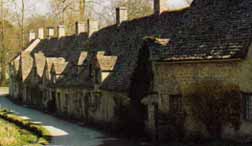
Less than five miles from Fairford is a tiny village called Bibury. William Morris, who was an English designer, called Bibury "the most beautiful village England." The village lies in the Coln Valley, along the River Coln. In England, any body of water is called a river, no matter the size. The River Coln is a lovely, clear creek, which is filled with trout that is bred at the Trout Farm. Rack Isle, a wildfowl preserve located near the farm, and is home to a variety of birds as well as wildflowers. As we wandered along this peaceful trail, we laughed with the ducks, awed at the swan, and searched the depths of the river for trout. Zack quickly spotted a large trout hovering in the waters.
The book we purchased about the village says, "Bibury has been considered a suitable spot for human habitation since prehistoric times." The atmosphere of this lovely village is so peaceful, we felt very much at home. We crossed a footbridge into a residential area, which is the location of a row of seventeenth century Cotswold cottages. Arlington Row was once a timber-framed wool hall used to hold wool for the Bishop of Worcester. It was later converted into the stone cottages and used as residences for the weavers who washed and dyed their cloth in the water that ran from the Arlington Mill. The National Trust now preserves these cottages. Henry Ford was so impressed by this quaint row of cottages, he tried to buy it and have it shipped to America.
|
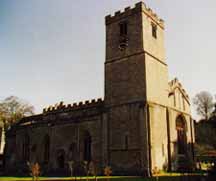
Arlington Mill was one of the largest corn mills in the Cotswolds. It was also used for fulling, which means cleaning, wool cloth for a short time in the seventeenth century. The building was restored and is now a museum.
In town, we visited St. Mary's church. There has been a church in this spot for at least 1150 years, as a church was recorded in the mid 8th century. Parts of the building still exist from this early Saxon church. Over the centuries it has been remodeled, according to the trends of the day, having evidence of Norman and medieval architecture. The building appears today as it did in the 15th century, though the east transept was remodeled in the mid 20th century.
Inside we spent a moment in prayer at the high altar, then wandered around the church, viewing the great tombs of the wool merchants whose financial support built the church over the years. Much of the interior is considered transitional in design, having aspects from Norman Romanesque through Gothic. Even the font is Transitional, with Norman rope carved into the shafts that hold up the bowl and Gothic arches carved into the panels on the bowl itself. The bowl on the font is square in shape, a rather unusual feature.
The churchyard is filled with ancient tombstones, some quite large, showing that there were periods of wealth from wool in this lovely place. The village went through bad times also, having been hit hard by the plague. There was also a period of revolt during the industrial age, when agricultural equipment began to replace laborers. During that time, riots and arson were targeted at the wealthy landowners that purchased the new machinery.
Today, the village is a lovely tourist site, a place to look at the past and enjoy God's creation today. We purchased some shortbread cookies in a shop and readied ourselves for our next stop, the village of Fairford.
Fairford is very close to the military base, a place where Bruce was stationed two decades ago. We wanted to walk around the village so he could see what changes have occurred in the years since he was last here. A few of the shops are different, the post office has moved and shop fronts have been remodeled, but the village has not changed very much over the years.
|
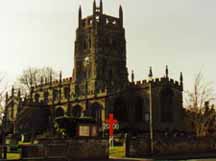
We took a few moments to visit the church in town where we planned to attend Sunday service. St. Mary's is a beautiful church. This is the only church in England whose complete set of medieval windows survived the reformation. The windows were whitewashed, which is how they survived the destruction of the reformers. At other times the windows were either removed or painted, particularly during the Civil War and during WWII. The west windows were damaged during a gale early in the eighteenth century, and have recently been removed for restoration. They are at York to be cleaned and repaired. Eventually all the windows will be like new.
Stained glass windows were an important part of the church. Most people were unable to read, due to the lack of books and oppression from those in power. Generally, the only people who could read were from the church, the monks and priests. The common folk could not read the bible for themselves, so they had to rely upon the church to teach them the story of Jesus. The windows and the sculptures, which decorate the churches, served as storybooks for the people.
After our visit in Fairford, Bruce drove us through the tiny country roads to the village of Eastleach Turville. There we saw the cottage where he lived with Charlie and Bradley, two other airmen from the base, and Laddie the dog. I imagine these young men created much havoc hanging out in their favorite pub, The Swan in Southrop. They also spent time with "Mum," our friend Joyce and her husband Dave. The guys did their laundry and spent hours playing RISK. It was fun for Bruce to share a bit of his history with us, and we enjoyed seeing these places from his past.
After a trip to the gas station and dinner at the bowling alley on base, we settled in to an evening of resting for our big day in Bath.
|
Bath Abbey and the Roman Baths

I recently shared with a friend the perspective that the sky is not blue. We had gone so long with cloudy skies, that I almost forgot what the sun and sky really looked like! I am pleased to say we were blessed with the most incredible weather for this trip to the West County. Saturday we traveled to the City of Bath, to see two thousand years of history and we were greeted with a lovely spring day.
I was rather surprized by the fact that Bath is built on a hill. From pictures I'd seen, I though it was a rather level place. As we neared the city, we could see the fine Georgian row homes clinging to the hillside, with their lovely white stone walls. We had some difficulty getting around town, finding a parking space, but eventually we settled into a lot and began our excursion around town. Bath is a lovely city, with plenty of shopping, restaurants and street performers to keep you excited about your visit. The history in town spans at least 2000 years, from the Romans to the modern age, though the area was inhabited long before the Romans appeared.
|
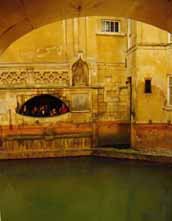
The legend claims that Bath was founded in 863 BC by Bladud, heir to the kingdom of Celts which lived in the area. He had severe leprosy, so was banished to keep pigs in the Avon valley. The water from the springs was found to have curative powers, so Bladud wallowed in the mud with his pigs. When people from his tribe discovered him bathing in the mud, they saw his leprosy had been cured, and restored him as king. The City of Bath was founded at those springs, and the goddess Sulis was worshipped there.
When the Romans came in 43 AD, they quickly established Bath as a frontier fort. Since cleanliness was quite important to the Romans, they built baths at the springs, which they also recognized as a holy place. The Romans recognized Sulis as their own goddess Minerva, so as the bath developed, so did a temple in honour of the goddess Sulis Minerva. For the Romans, cleanliness was next to godliness, and at Bath that statement took on a deeper meaning. The Baths, called Aquae Sulis, were famed for their healing. Sulis Minerva was also a goddess of war. Many pilgrims came to the springs, from the Celts to the Romans and beyond, to pay homage to the goddess by throwing gifts of coins into the sacred bath. Other pilgrims threw curses into the bath, asking the goddess to seek revenge on their enemy. The curses were written on pewter or copper, rolled then thrown into the waters.
|
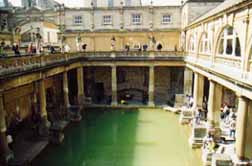
The great baths and the surrounding temples developed during the entire occupation of the Romans in Britain. The temple was typically Roman, with columns and carved rock pediments, however the pictures were a mixture of Romanesque styling and Celtic imagery. On the great temple pediment is the picture of the Gorgon. Though Gorgons were female, the one on this temple is quite masculine and reminiscent of Sol, the sun god. The round figure of Gorgon with flying hair has symbols that could have represented the elements, though the real meaning of the images has been lost to history. It is fun to look upon these ancient carvings and try to understand the people who created them.
One thing I find most amazing about these ancient towns, is how they have been built up over the years. When one civilization fades, the next just builds upon the rubble. The modern City of Bath is about 15 feet higher than the level of the Roman town. When the Roman Empire crumbled, so did the baths. A monastic community was built near the site of the Roman Temple, and pilgrims continued to come to the springs for healing. Throughout the centuries, Bath Abbey rose and fell, as did all the monastic communities. The current building dates from 1499, and now serves as the Church of St. Peter and St. Paul. There is evidence of Christian worship on the site since about 350 AD.
The Baths were rediscovered over the centuries, during construction work around town. Early in the seventeenth century, Queen Anne of Denmark came for the healing power of the spa. From that time, Bath became a resort community, where royalty and other notables spent time bathing in the pool and enjoying each other's company in the Pump Room. It was during the Georgian period in the 18th century, when the fine buildings, which dominate the skyline of Bath, were designed and built.
Of special note is the Royal Crescent, a row of townhouses shaped like a crescent. One hundred columns decorate the façade and the building is made of the soft local limestone which is light golden in colour. These homes were built as vacation getaways, rented for "The Season" by the privileged. Each townhouse has five floors; a basement for the service rooms, the main floor with the living areas, two floors with bedrooms, and the topmost floor for servants quarters. These were fully furnished, the occupant brought with them some comforts and servants from home, hiring everything else they needed. "The Season" in Bath was October to March, the winter months, since the summers were spent at the beach. The visitors often stayed for several months, enjoying the baths, the company and the revelry around town. When Bath lost its favour with the jet set, the Royal Crescent fell to disrepair. In the 1960's these homes were sold for incredibly cheap prices, restored and turned into condos or private homes. The centre two homes have been converted into a hotel. In front of the Crescent is a great lawn. Apparently at some point, cattle roamed freely on this large expanse of grass. A wall was built about halfway up the lawn to keep the cattle from getting to close to the homes. It was built in such a manner that it is unseen from the homes in the Crescent at top of the lawn.
Another particular favorite of architecture enthusiasts to visit is The Circus. This circle of thirty-three townhouses surrounds parkland with grass and tree. The blocks each have eleven homes and are equally divided by three entrance roads. A road runs around the circle. Around town are many other buildings made from the lovely Cotswold stone in the Georgian style, recalling the days of splendor. Mingled in those grand homes, you'll find some older buildings, including Sally Lunn's Bakery, and some modern buildings. It is a town with an interesting atmosphere which reaches beyond this moment into the past, while being a thriving modern community.
When we arrived in Bath, we headed straight for the Abbey. In the vault area, you can walk through the Christian church in Bath over the last 1650 years. Visual displays, charts, graphs, scripture, as well as actual archeological evidence tells the story of the church in Bath. There is an open grave on display, showing a woman who was buried in about 1200. Another place shows the foundations of the buildings on that site, from the Roman street level through the modern church. The Monastery at Bath was known for its book publication, which before the printing press was all done by hand. Edgar, the first king of England was crowned in Bath Abbey in 973 AD.
I noticed as we roamed around the church that there was a large number of memorial placards on the walls. This was a sign of wealth of Bath. The fee to be buried in the church was not inexpensive, and the estimate is 2000-3000 bodies are buried under the floor. Nearly every inch of space is covered with marble placards for nobles and gentry who were interred inside the abbey walls. There are beautiful high vaulted ceilings and a window at the south transept called the Jesse Window, which shows the genealogy of Jesus Christ.
|

Bath Abbey Church was one of the last of the great churches to be built before the reformation. It is Gothic in style with high arches and flying buttresses. Oliver King, the new Bishop of Bath had a dream where he saw angels climbing up and down a ladder from heaven, accompanied by the words, "Let an Olive establish the Crown and let a King restore the church." He depicted this dream in the design of the West Front. On either side of the window are two ladders with angels appearing to climb up and down. Those who are climbing down are upside down.
After our visit in the church, we stepped into the sunshine and discovered how truly popular a visit to the Roman Baths really is. The line was long to get in, but since it was the purpose of our trip, we joined the throng of curiosity seekers and waited patiently for our turn. We wondered at the price of the tour, £17.50 for a family of four. I thought, "that much to look at a swimming pool?" When we finally got into the museum, we were not disappointed. We spent nearly two hours roaming through the many rooms of the Baths, from the Great Pool, to the saunas and other pools which were used for the Roman bathing process. There was one semi circular pool that was specifically designed for healing purposes, with special plumbing to create a whirlpool effect. We were shown the technical ingenuity of this greatly advanced civilization with its plumbing and central heating. We gazed upon the sacred pool, where pilgrims sought healing and revenge from the goddess Sulis Minerva for centuries. We viewed the many finds from the original temple area, including a bronze cast of the goddess, a most incredible find, since it would have been quite valuable.
|

The spring itself is a fascinating study. The water has been in the ground some 10,000 years, having been to the very depths of the earth itself giving it the hot temperature. It is high in mineral content with 43 different minerals present from all the layers of stone, which it travels through on its way to the surface. The rate of flow from the spring is 13 litres per second or 250,000 gallons a day. The ingenuity of the Romans even shows in the well-designed and still used drainage system for the excess water. The temperature of the water is 115º F.
We had an audio tour to listen to at our leisure, which gave us interesting information about what we were viewing. We learned about the Roman ritual of cleaning. The wealthy Romans would hang out in the tepidarium (warm room) to show off to their friends. They would battle of the largest number of servants or the finest oils for their skin. There, the servants would cover their skin with the oil before they entered the caldarium, a hot room. Then they would jump in the cold plunge to cool off. Another room, the laconicum was like a sauna. Back in the tepidarium, the servants would use a strigil to scrape the oil and dirt from their skin. They even had the hair plucked from their armpits.
The Baths were more than just a place to get clean. Here men met on business, somewhat like the golf course is used today. Young people listened to philosophy and games were played around the pool. In Roman times as well as the later centuries, the Baths were a place of fellowship, business, and recreation.
After roaming through endless passages of museum, we finally came to the end, a trip into the Pump Room for a taste of this spring water. The water was warm, and very strong in flavour with the high mineral content. Zack did not enjoy the taste, though the rest of us did not find it offensive. We enjoyed our visit to this amazing ancient marvel and would recommend it to anyone who is in town.
It was getting late in the afternoon, so we searched the streets for a place to eat, settling for the usual fast food when we are rushing to see all we can see. After a moment in Burger King, we wandered through a few of the city streets and found a tiny fabric shop where I was able to purchase some supplies I need for a project. Then we went to visit the museum at Sally Lunn's House. This bakery is the home of the Original Sally Lunn Bun, a light large round bread used for sandwiches. Below the restaurant is a tiny museum, which shows what the kitchen would have been like in the 17th century when Sally began baking the bread. Another area shows the different levels of foundation, from the Roman street through the Medieval foundations. We purchased one of Sally's famous rolls and some postcards, then moved on to our next adventure.
We wanted to go visit No. 1 Royal Crescent, but the walk was much too far, so we moved the car to a closer lot, after nearly getting lost on the city streets. We then climbed the hill to the building. Along the lawn, people of all ages were enjoying the sunshine and lovely weather with picnics and ball games. The museum we visited showed what the house would have been like in the height of a Bath Season. This home was lovingly restored and filled with furniture from the 18th century. Each room had a guide who told us about the interesting features in the room. A particular favorite was the cupboard in the study where the chamber pot was stored, as there were no bathrooms in the homes.
We wandered back to our car, and headed to our final destination for the day, Cirencester. It was late in the day, but we were trying to reach the town before the Tourist Information Centre closed. Unfortunately, we had so much fun in Bath we arrived shortly after the closing time. The town was very quiet, but we took a few moments to wander around the church and through a lovely park. The weather was so warm on Saturday, it was a pleasure to spend some time looking at the daffodils and watching the ducks at play. Cirencester was another Roman town, and we found the ruins of the town wall. The kids had fun climbing over the rocks and running up the hills.
We were all very tired from our busy day, so the next stop was our room in the hotel. We managed just enough energy to go to the Bowling Alley for a take-out pizza and some chili fries to enjoy in our room. We needed to rest for our final day away, and be ready for our visit to St. Mary's Church in Fairford for worship.
|
Our Final Adventures, Worship and a Horse
|
I tend to over pack for vacations, and this weekend jaunt was no exception. We are never sure if we will be able to get something that we need while visiting these out of the way places. The base where we were staying is quite small, so shops are not open very many hours. The village near the base is not very big and the concept of a 24-hour Seven/Eleven has not reached into the heart of the English countryside yet.
We awoke Sunday morning, ready to visit the lovely Parish church of St. Mary's Fairford. Bruce decided to shave off the stubble that had grown over the past few days, but realized that his shaver did not work. Of all the things we packed to be prepared for any emergency, a razor and shaving cream was not one of them. He was able to purchase those things at the reception desk. After cleaning our messes, we checked out of the hotel and went into the village for church.
The weather was not quite as nice on Sunday morning as the previous two days, but since we were going to start for home, it did not matter if it rained. We arrived at the church a few minutes early, so that we could watch the bell ringers in action. Most churches have the bell cords high above the congregation, often hidden by curtains. St. Mary's, however, has cords that reach to the ground. The team stands in the midst of the quire, and plays the music where everyone can watch. Each person pulls one cord, and together the bells make beautiful music. The task looked exhausting, reaching high for the cord and pulling hard to ring the bell. This went on for at least fifteen minutes, and I was awed by the commitment of each person to his or her task.
The service began, and was a rather typical Church of England service, with Holy Communion. The difference we saw this day was that they prepared the bread and the wine in the midst of the congregation and had one family help with the preparation. The elements were then taken to the high altar for the distribution. We sang lovely songs, and I really felt the presence of God in the congregation that day. The church was nearly full, with a choir of nearly 30 people, from children through adult, singing God's praises.
After the service, we joined the congregation for tea in the hall, and visited with several of the people. One man shared a few things about the church we had not seen on our visit Friday afternoon. So we got the cameras out of the car and went to see the inside of the church once again.
St. Mary's was once connected to a monastic society, and therefore had monks who prayed often within the church. Close to the high altar are some chairs, which the monks used for these prayer times. They often spent hours on their knees reciting the mass, so these chairs were built so that they could lean against them. These misericords were decorated with domestic scenes, some of which were rather bizarre in a church setting. I found a carving of a woman with something raised high above her head holding the hair of her husband while dragging him along the floor. There was also a carving of a woman about to beat a dog for being in the butter church. Each misericord is unique, some with evil pictures of monsters, others with pictures of pheasants or angels.
While we were in the church, we took more time with each window, noticing the detail of the stories and designs. The picture of Jesus' Ascension shows only his feet in the clouds. Other pictures include backgrounds, which were typical of the medieval period, with large castles and medieval costumes on the people. The colours and design of the windows are magnificent, a joy to 'read' the stories of the bible told in light and picture.
|

We left Fairford and drove south, for our final stop of the day. Around the hills of the West Country are white horses. These ancient drawings in chalk dot the hillsides, for reasons we can only guess. Most of the white horses are more recent restorations of ancient drawings, carved into the chalk foundation below the surface of the earth. These horses date from the 18th and 19th centuries. There is one, however, which dates much earlier. White Horse Hill, near Uffington, is believed to be 5000 years old. It has been restored over the years, and for the last century or more has been recarved every seven years. This horse is more a line drawing, more visible from the air than from the ground, but it is interesting to visit such a treasure of English countryside, and to see it from the roads all over the area. We took a moment at the site to take a few pictures and to enjoy a soft Ice Cream.
|
TODAY'S WORD
Home and Away
Site Map









